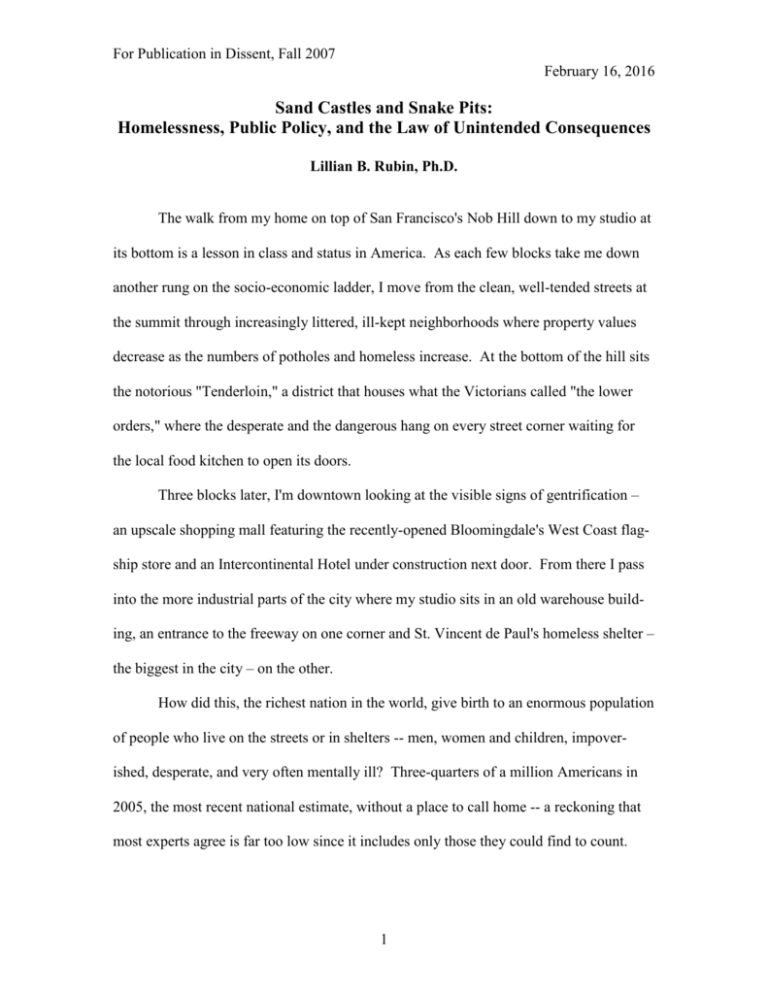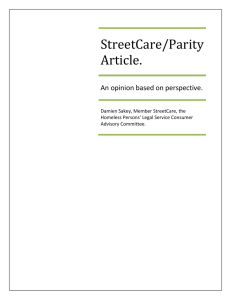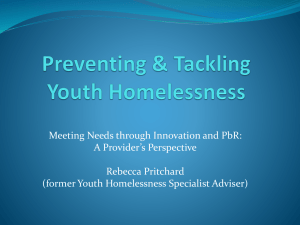Mental Health Reform and the Law of Unintended Consequences
advertisement

For Publication in Dissent, Fall 2007 February 16, 2016 Sand Castles and Snake Pits: Homelessness, Public Policy, and the Law of Unintended Consequences Lillian B. Rubin, Ph.D. The walk from my home on top of San Francisco's Nob Hill down to my studio at its bottom is a lesson in class and status in America. As each few blocks take me down another rung on the socio-economic ladder, I move from the clean, well-tended streets at the summit through increasingly littered, ill-kept neighborhoods where property values decrease as the numbers of potholes and homeless increase. At the bottom of the hill sits the notorious "Tenderloin," a district that houses what the Victorians called "the lower orders," where the desperate and the dangerous hang on every street corner waiting for the local food kitchen to open its doors. Three blocks later, I'm downtown looking at the visible signs of gentrification – an upscale shopping mall featuring the recently-opened Bloomingdale's West Coast flagship store and an Intercontinental Hotel under construction next door. From there I pass into the more industrial parts of the city where my studio sits in an old warehouse building, an entrance to the freeway on one corner and St. Vincent de Paul's homeless shelter – the biggest in the city – on the other. How did this, the richest nation in the world, give birth to an enormous population of people who live on the streets or in shelters -- men, women and children, impoverished, desperate, and very often mentally ill? Three-quarters of a million Americans in 2005, the most recent national estimate, without a place to call home -- a reckoning that most experts agree is far too low since it includes only those they could find to count. 1 For Publication in Dissent, Fall 2007 February 16, 2016 How did homelessness become so pervasive that a college student in the class on poverty in America I taught a few years ago couldn't conceive of a world without "the homeless?" "Are you saying there didn't used to be homeless?" he asked, bewildered. "They've always been there, all my life," he continued, as other students nodded assent. How is it that even those of us who remember a time when homelessness was something that happened in India, not here in these United States, have become so inured to the sight of people living on the street that we walk past and around them without really seeing them? Maybe it takes a few years of working next door to people without homes to see them, not as an undifferentiated mass – "the homeless" – but as men and women (mostly men) with whom I share a greeting when I arrive in the morning, people with names and faces and hard-luck stories. They're unclean, unkempt, and with a bone-deep weariness that seems to seep out of their pores, yet someone offers help when he sees me struggling to manage more than I can comfortably carry up the stairs. And once, when I tripped and fell, another picked me up off the sidewalk, wiped the blood off my face (Never mind that he pulled a filthy rag of a handkerchief out of his pocket to do the job), and despite my protests, refused to leave until he saw me safely to my destination. Homelessness in America isn't new, but it had a distinctly different flavor and meaning in earlier times. Then, homelessness was a transient phenomenon, generally tied to a sudden seismic event or the cycles of the economy. The Great Depression, for example, spawned a "hobo" population, mostly men from rural and urban communities who wandered from one part of the country to another in a desperate search for work that didn't exist. But when the Depression lifted and the economy brightened, they found jobs 2 For Publication in Dissent, Fall 2007 February 16, 2016 and homes. American cities, too, have always had pockets of homelessness, the skid row "bums" in neighborhoods like "The Bowery" in New York, "West Madison" in Chicago, "The Tenderloin" in San Francisco where the poor, the transient, the sick sought escape, and where alcoholics, still clutching the bottle, could be seen sleeping on the streets. But modern homelessness isn't just about "bums" or "hobos," nor is it confined to some small out-of-sight corner of the city. Instead, it's on our streets and in our face and, for those of us who live in any major city in the country, an inescapable fact of life. They're black and brown and less often white; they're usually single and mostly men. For some being without a home is episodic, the result of an illness, an injury, a layoff, or for some of the women, domestic violence. The problem clears, and they're back on their feet -- at least until the next time. But for hundreds of thousands of Americans, homelessness is a near-permanent, chronic condition from which there is presently no real escape. The large structural forces that have changed the face of homelessness are no mystery: an increasingly stratified society with little opportunity for the unschooled and unskilled, a minimum wage that doesn't approach a living wage, unemployment and underemployment, cuts in public assistance, and urban rents that continue to rise well beyond what an unskilled worker can afford. But all of these together would not have created the scale of the problem we now face without the aid of two major public policy initiatives: the Housing Act, passed by Congress in 1949, and the Community Mental Health Centers Act, signed into law by President John F. Kennedy in 1963 – good ideas with lofty goals whose unintended consequences we see in the legions of homeless on the streets of our cities today. 3 For Publication in Dissent, Fall 2007 February 16, 2016 In the landmark Housing Act of 1949, Congress declared that every American deserves a "decent home and a suitable living environment" and instituted a complex set of provisions to achieve that goal. For the growing post-World War II middle class, the increased authorization for the Federal Housing Administration (FHA) mortgage insurance (known as Title II) was a bonanza that helped millions realize the dream of homeownership. But for the poor, Title I, which called for an urban redevelopment program, became a disaster when its stated intent -- to provide federal funds to upgrade decaying inner cities -- fell victim to greedy local governments and the developers in their employ. Urban renewal, as it was known, soon became little more than an excuse for "poor removal" as bulldozers and wrecking balls demolished entire neighborhoods, some of them home to poor but vital communities, others featuring the shabby tenements, boarding houses, and dilapidated hotels that offered single-room occupancy (SRO) housing to the poor, the lonely, the debilitated, the ill, and the drug addicts. And despite a provision (Title III) that committed the federal government to building 810,000 new public housing units -- – another policy that experience has shown created at least as many problems as it solved – local, state, and federal governments looked the other way as urban renewal, with its promise of increased land values, quickly came to replace concerns for housing, and far more living units were destroyed than were built. This isn't to say that urban renewal was a failure for everyone. Not by a long shot. Parts of many inner cities did, indeed, become more attractive as blighted neighborhoods were cleared for such amenities as hotels, shops, cultural centers, and even small patches of green. But in the game of winners and losers, it's no surprise that only the poor lost. The developers lined their pockets. Local governments reaped the reward 4 For Publication in Dissent, Fall 2007 February 16, 2016 of increasing land values as the new steel, concrete, and glass towers attracted business that brought jobs and revenue to the city. The glossy high-rise condominium buildings that rose in place of rundown homes, tenements, and SROs brought the affluent, who had fled to the suburbs decades earlier, back to the city where they could now live in style and comfort while enjoying the convenience of having Macy's, Neiman Marcus, a bank branch, and the city's cultural offerings at their doorstep. Only the poor and the sick were left with no place to go, except into the streets or the public housing projects that now look and are more like prisons for the poor than the "decent home and suitable living environment" Congress declared as every American's right. Lest anyone think urban renewal is a thing of the past, I'll be happy to take them on a tour of the projects under way in my hometown of San Francisco or, if that's too far to go, to direct them to a New York Times article (June 16, 2007) whose opening words tell the story: "For nearly three decades, Charlotte Johnson witnessed the drug dealing and violence on the streets in front of her modest row house in East Baltimore. She rode it out only to face a new challenge today — the community’s transformation under the largest planned urban renewal in the country, which could soon drive her out of the neighborhood." Step back to the past again, to 1963 and the Community Mental Health Centers Act, another historic piece of legislation whose good intentions would set the stage for yet another social debacle. The American mental health reform movement has a long and not very successful history. In 1868, after Elizabeth Packard was released from an asylum to which her husband had committed her some years earlier, she founded the AntiInsane Asylum Society and published a series of pamphlets describing her experiences. 5 For Publication in Dissent, Fall 2007 February 16, 2016 Shocking as her tale was, her entreaties for public attention fell on deaf ears because most people then still believed that madness was the result of demonic possession. Forty years later, Clifford W. Beers' A Mind that Found Itself was somewhat more successful in stimulating public interest, but it would be several more decades before The Snake Pit, a film starring Olivia de Havilland, opened in 1948 to a stunned American audience. Everyone knew, of course, that there were insane asylums, places where crazy people were locked up so the rest of us could sleep easily at night. But it is testimony to the power of film that the visual images woke the American conscience in ways that hundreds of thousands of written words had not. Suddenly, the "insane" were not just some undifferentiated mass, they were women and men hidden from view in human warehouses, held in the care of sadistic guards, shackled to walls in dungeon-like cells, and subjected to torturous "treatments" -- immersed in tanks of ice-water, spun in chairs for hours, secluded naked in isolation rooms, restrained in straitjackets or cuffed hand and foot to a bed in spread-eagled position, force-fed medications, shocked with high volts of electricity to the brain, and lobotomized – all by psychiatrists who knew little about the cause or relief of their symptoms. Still, the mental health reform movements didn't gain any real traction until the mid-1950s when the development of psychotropic medications gave promise of symptom relief, if not a cure, for some of the worst of the mental ailments. Although the new drugs were not without significant and often dangerous side effects, thousands of patients were taking them and, by the end of the decade, people who would once have been committed to asylums for life were managing to live outside them and tell their stories. 6 For Publication in Dissent, Fall 2007 February 16, 2016 The hope the new medications brought, coupled with the various rights movements that were roiling society in the 1960s, set the stage for the emergence of a vigorous patients' rights movement, led largely by former hospital patients and their families. They offered a stinging critique of institutional psychiatry that was instrumental in discrediting the practices and treatments that had turned hospitals into snake pits, called for an end to involuntary commitment, and demanded that patients have a voice in their treatment. What happened? It's always easier for the federal government to spell out good ideas than it is to put up the hard cash necessary to make them work. So perhaps the simplest explanation is that the road to hell is paved with unfunded and under-funded government programs. Still, there's rarely a single cause to explain either the success or failure of a policy initiative. As the social and political background changed in the decades following the passage of the Community Mental Health Centers Act, the good intentions that brought it into being faded away. The Vietnam war was a continuing drain on the public purse. Tax revolts and anti-government ideologies of both the right and the left blossomed in the 1970s, which, together with the recession of the early 1980s, further weakened both the government coffers and its resolve. Ronald Reagan's election to the presidency in 1980, turned a budding conservative movement into a full-scale revolution that changed the American social and political landscape for decades to come. All these played a part in restricting federal funding for social programs, including mental health, so that by the mid-1980s the regional funding model the 1963 law promised -- never enough even at the 7 For Publication in Dissent, Fall 2007 February 16, 2016 beginning -- was scaled back, and mental health services shifted once again to state and local levels until now, when federal funds support only about 2 percent of total state mental health budgets. But long before federal funds dried up, the states played their part in turning a good idea into a fiasco. Until the new law, mental health care was the province and the burden of the states. When the federal government entered the picture with a plan for community care and the promise of funds to support it, it was a gift that offered states relief from the enormous financial costs of supporting a large hospitalized patient population. Not surprisingly, therefore, state and local officials spoke the language of mental health advocacy and community care, but they acted on their concern for fiscal policy. Without waiting for the promise of the law to become a reality, they jumped on the deinstitutionalization bandwagon and transferred tens of thousands of mentally ill women and men, many who had spent years in confinement, to communities that had no way to support their care. Before long, the few Community Mental Health Centers (CMHCs) that existed were overwhelmed by demands they simply couldn't meet. It was a devastating experience for both the patients and the professionals. "We had no choice but to turn people out into the street," one veteran of the time recalls. "The state hospital, the place of last resort, was gone; there were no halfway homes, no treatment programs, nothing." Yet deinstitutionalization continued, ultimately closing nearly half the hospitals in the country and dramatically reducing bed capacity in those that are left, leaving uncounted tens of thousands of people to fend for themselves. 8 For Publication in Dissent, Fall 2007 February 16, 2016 Although thousands of deinstitutionalized patients made a more or less successful transition to life outside the hospital, living with families or in adult group homes where they existed, many others fell through the cracks – and are still falling. For serious mental illnesses like schizophrenia and bi-polar disorder are never a one-time problem that can be cured with a pill. In one way or another, even patients who seem to be doing well need regular monitoring and counseling if they're not to slip and fall. Moreover, welcome as each new generation of psychotropic drugs has been, they are no free lunch for the men and women who must live on them to maintain their sanity. For along with the gift of gaining some control over the delusions of schizophrenia or the excessive mood swings of bi-polar disorder, come side-effects that can range from such discomfiting problems as weight gain and blurred vision, to serious and sometimes irreversible neuromotor difficulties with Parkinsonian symptoms that can disfigure a life. In addition to physical side effects that can be almost as disabling as the disease itself, drugs that alter the mind also alter consciousness in ways that challenge a person's experience of self. Patients often complain, therefore that they "feel different," that, as a patient said to me some years ago, "I feel like a stranger to myself" -- feelings that drive a very large proportion of the mentally ill to stop taking the drugs, which inevitably throws them into crisis. Ask any family with a schizophrenic or bi-polar member, and you'll hear stories about the weird and sometimes dangerous behavior that suddenly appears when the patient secretly stops taking his medication. Listen to them speak of the difficulty of finding their way through the chaotic maze of uncoordinated public agencies that is now our mental health system, only to fail because there are no beds or community services avail- 9 For Publication in Dissent, Fall 2007 February 16, 2016 able. Hear their agony as they describe what it's like to find a loved one living on the street and feel helpless to do anything about it. In the recent uproar about the Virginia Tech shootings, the executive director of the Virginia Commission on Mental Health Reform was asked why a young man who had been diagnosed as "mentally ill and in need of hospitalization" wasn't either hospitalized or closely monitored in an outpatient setting before he walked onto the campus and killed 32 people. His reply? "The system doesn't work very well." An understatement of breathtaking proportions. Whether homelessness or crazed killing sprees, they don't happen because "the system doesn't work well," but because it's broken, not just in Virginia but throughout the land. The Virginia Tech shooter wasn't closely monitored by mental health professionals because, whatever the services his community may say it offers, there simply are never enough resources or staff to provide them. Homelessness isn't an accident or an artifact of some strange modern urban disease, but a product of failed social policy. It got its first big push when urban renewal destroyed poor neighborhoods without offering adequate housing alternatives. Deinstitutionalization shoved it even harder when the plan to provide community-based mental health services turned out to be an empty promise, starved of funds even before the first patients were sent off to find their unsteady way into communities that had no services or facilities for them. And while all this was happening, the patients' rights movement won victories in the legislatures and the courts (including the United States Supreme Court in Olmstead v. L.C.) that make it virtually impossible to hold someone with serious and sometimes dangerous mental problems involuntarily for more than a few days without proof, certified by a court, that he's an immediate threat to 10 For Publication in Dissent, Fall 2007 February 16, 2016 society and/or himself – a test that isn't easy to meet absent violence or proof of intent to commit it. "You think it's a problem, just try living with it," sighed the director of a clinic with whom I spoke recently about the mental health problems of the homeless. "We try, but we don't have the staff or the resources. And even if I could find a bed for some of the worst of them -- which, frankly, I usually can't – if they don't want to go, the law won't let me hold them for more than 72 hours no matter how crazy they are. So what's the point? You knock yourself out to find a place where maybe, just maybe, they can get help, and a couple of days later, they're back out on the street." True, but even for those who are amenable to treatment, the best any mentally ill homeless person is likely to get these days is a bed to rest in just long enough for the doctors to find the right drug regimen to stabilize a crisis. After that he or she is back out into the community with no services, no follow up, and no place to live – a revolving door that never stops turning. The result? About 500,000 of the 750,000 homeless Americans, men and women who are sick, desperate, and without hope, presently live in shelters or on the streets because of some form of mental illness. Yes, as I've already said, there are other social and economic forces that have contributed to the rise of homelessness. But the virtual epidemic we know today wouldn't exist without the fallout from two historic public policy initiatives: the Housing Act of 1949 that set urban renewal in motion and the Community Mental Health Centers Act of 1963 that sought to reform the mental health system – both well-intentioned, if flawed, good ideas that fell victim to the law of unintended consequences. 11 For Publication in Dissent, Fall 2007 February 16, 2016 Do we conclude then that good intentions, don't matter, that, as conservatives would have it, it's the nature of government to make a mess of even the best ideas, and that, therefore, we need less and less government intervention, no matter what the intent? I don't think so. True, government is not always as efficient as we'd like it to be. It's too cumbersome, too often unprepared for the unforeseen consequences of its actions, too slow to correct its mistakes, and our legislators are too often more beholden to special interests than to the common good. But even in a pluralist democracy like ours, where legislation is the product of compromise and negotiation that can subvert the framers' good intentions, it doesn't always happen that way, as the Social Security and Medicare programs aptly demonstrate. Not that they're perfect, not that the compromises made to ensure their passage haven't left their mark. But compare the successes of the original single-payer Medicare program to the recent Medicare Prescription Drug Benefit – a complicated bureaucratic nightmare that relies on the private sector to provide insurance. Despite the fact that our costs exceed anything government-insured programs spend in countries that offer better, cheaper, and more complete drug coverage, Medicare Part D, as the drug benefit is known here, has brought far more benefit to the insurance companies and their pharmaceutical allies than to the old and the sick. How, then, do we avoid the unintended consequences that can cause the kind of social dislocation and personal pain I've described here? Perhaps we can't; perhaps it's in the nature of the system – any system – that we can't always foresee the pitfalls until we tumble into them. But the problems of legislation like the Medicare Prescription Drug Benefit should remind us that it isn't government's attempts at reform that need to be curbed but the influence of corporate America on the legislative process. Indeed, recent 12 For Publication in Dissent, Fall 2007 February 16, 2016 experience – the turn to the private sector for what earlier had been part of the public trust, the many revelations of corporate malfeasance, greed, and incompetence – suggests that only the willfully blind can continue to insist that the government has no place in reform and that private sector will always do it better and cheaper. 13








